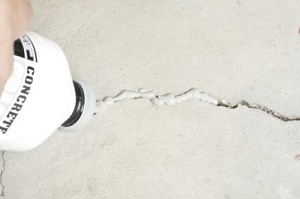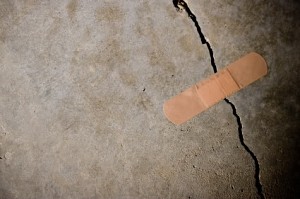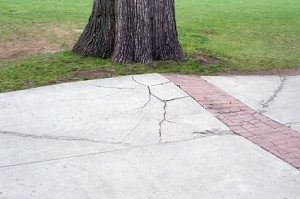Concrete Driveway Repair: When to DIY and When to Call a Pro
Don’t procrastinate on concrete driveway repairs. Problems may expand and worsen if you wait. Handy homeowners can perform many of these repairs themselves, unless the problems are widespread or caused by serious structural issues. Here are the most common concrete driveway repairs, listed from simplest DIY fixes to more complex, professional jobs.
Perform Small DIY Repairs
Temporary fix for cracks. Isolated cracks and holes in a driveway require simple DIY filling work. Concrete caulk is a fine temporary fix to keep a minor crack from spreading as water seeps in. It's a particularly good idea in winter, when weather conditions aren’t ideal for concrete work, but water might slip into a crack, freeze and expand if the crack isn't filled.

Concrete caulk is good for a temporary DIY fix for a minor crack.
More permanent repair. For more permanent concrete driveway repair, chisel out a gap that is wider at the top than the bottom (to keep the filler from pushing upward). Brush in latex bonding glue and fill the gap with patching compound. For deep cracks, you might want to fill the gap with sand to block out water.
Deal with frost heave. Frost heave can create a little more work, but it’s still a straightforward DIY job for handy homeowners. In winter climates, expanding frozen soil can push concrete upward. Remove the areas that popped out and repair or replace the subbase.
Fill small holes. Cut straight, clean edges by holding a masonry blade at a 15-degree angle and chiseling out the concrete. Then fill with vinyl-reinforced patching compound in thin layers and wait about 30 minutes between layers. The top layer should end up just higher than the surface, with feathered edges beyond the original hole.
Be sure to cure the repaired area by covering it with plastic sheeting for about a week, checking to make sure it stays damp. Also consider adding a coat of masonry paint to help the patched area match the rest of the driveway.

Some concrete repairs are a bit more complicated than sticking a band-aid on top.
Solve Widespread Cosmetic Issues
A lousy initial concrete job can cause many cosmetic surface problems. This includes: small chunks that popped out of the driveway and left it looking like the surface of the moon, a maze of hairline cracks resembling a haphazard river network, and thin upper sheets of concrete that sheared off.
In most of these cases, a thin resurfacing job will probably solve the problem and serve as a complete concrete driveway repair. If you did the initial work, you may not have floated or mixed the concrete properly. You may want to hire a pro to clean up your work. Likewise, it’s probably time to find a new contractor if the work was done professionally.
Find Professional Solutions for Larger Problems
While concrete contractors would be happy to take your money to help you with any of the above work, a sunken slab truly requires an expert for proper and permanent repair. Subbase erosion causes most concrete sinking, and you should probably hire a mudjacking contractor to add fresh concrete under the surface.

For major concrete problems, it's best to hire a pro.
Attack concrete driveway repairs early and try a simple DIY patch, unless sinking and widespread cracking indicate a more serious problem.
Updated February 20, 2018.
Looking for a Pro? Call us (866) 441-6648

Concrete Average Costs
Concrete Contractors Experiences

The Stamped Concrete Patio I’ve Been Waiting For

Rotted Fence Repair Taken Care Of Fast And Efficiently



